 Because you and your friends have (inexplicably) decided to spend Halloween swapping ghost stories in Buell Hall, Bwog sees fit to remind you of the institution that preceded ours on campus grounds. Bringing you the exposition you need for your night in a horror movie, Bwog correspondent Anna Hotter investigates the Bloomingdale Insane Asylum.
Because you and your friends have (inexplicably) decided to spend Halloween swapping ghost stories in Buell Hall, Bwog sees fit to remind you of the institution that preceded ours on campus grounds. Bringing you the exposition you need for your night in a horror movie, Bwog correspondent Anna Hotter investigates the Bloomingdale Insane Asylum.
It’s easy to forget that Columbia only moved to Morningside Heights in 1897, but before there were Beaux Arts buildings lining Broadway, our neighborhood was home to a different institution entirely. From 1821 to 1892, the expanse of this campus was occupied by the Bloomingdale Insane Asylum, the first public infirmary of New York City.
Bloomingdale shares several connections with Columbia. For one, it was founded on the same charter as New York Hospital (now New York Presbyterian), which in turn was petitioned for by professors of King’s College. The grounds purchased were mostly farmland, and, as we can see in early renderings of the asylum, Morningside Heights looked a lot more like Westchester than New York during that time.
The asylum initially consisted of just one main building, which approximately stood where Low is today, on “117th Street between Tenth and Eleventh Avenues.” Bloomingdale was three stories high and was divided into three different tracts. In the middle portion were the administrative offices and the employees’ quarters, while the men’s and women’s wards were on each side. The patients’ rooms were “nine feet six inches long, (…) six feet six inches wide,” making them a tiny 61 sf (for comparison, the smallest room at Columbia measures 76 sf). The asylum also had a prominent farm and garden, which spanned across 55 acres. It was devoted “to grass, vegetables and ornamental shrubbery” and bore a strong resemblance “to the beautiful homesteads of the wealthy, in the rural, cultivated districts of England.”
While the exterior of Bloomingdale might have looked beautiful, the ongoings inside it were far from perfect. Throughout its career, the infirmary was home to several thousand patients who were admitted for ailments like mania, nymphomania, “idiocy,” or “moral insanity.” In the period between 1821 and 1844 alone, 258 patients died, and several “eloped.” This was apparently not without reason, as Bloomingdale, like many other insane asylums of the period, subscribed to somewhat questionable treatment methods. As was also customary in those times (and on American Horror Story), a journalist had himself admitted to Bloomingdale, and published several exposés about those practices. It was apparently not uncommon for wardens to hit their patients, and at night screaming could be heard throughout the buildings.
Shortly after the stories were published, Bloomingdale was closed, and moved to White Plains together with other facilities of New York Hospital. Columbia purchased the property in 1892, and even used some of the asylum’s old buildings for the first couple of years.
Looking at the Morningside Heights campus today, we can still see remnants of its previous tenant. Most notably, of course, there is Buell Hall, or the Maison Française, which is the only building left over of Bloomingdale. Its initial name was the Macy Villa, and it served as lodging for some of the wealthier patients. The Macy Villa had a large wooden porch that surrounded the entire building, which has since been taken down. Otherwise, Buell Hall’s exterior looks pretty much exactly the way it did in the 1800s.
A much more subtle reminder of Bloomingdale can be found in an unexpected place: The Heights. You’ve probably noticed that the bar’s layout is triangular, and this is because it used to be next to Asylum Road, which stretched diagonally across Morningside Heights.
But apart from Buell Hall and the occasional oddly shaped building, there isn’t much left over from Bloomingdale. When I talked to some friends about our strange predecessor while doing research for this write up, I was surprised to see how few actually knew about it. So the next time you walk past the Maison Française, or are having a Mango Margarita, you can think about all the weird stuff that went down – at the very least, it will make a good ghost story for Halloween.
- Where Asylum Road would have been
- An early view of campus with the Macy Villa and another one of Bloomingdale’s buildings visible
- Revising rules made when Columbia looked like this
- A map of Bloomingdale
- Another B&W shot for good measure
- Morningside Heights or Westchester?
- The ornamental shrubbery


 2 Comments
2 Comments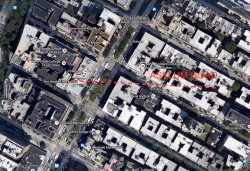
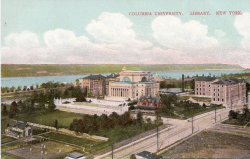
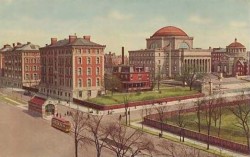
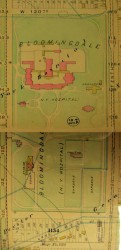
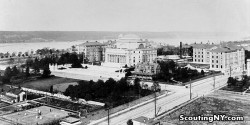
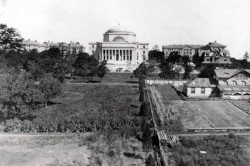
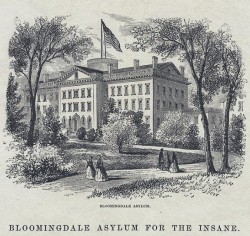

2 Comments
@matt Good Read. I love learning about Columbia’s history!!!
@Alum There was also an orphanage in the neighborhood back then. One of its buildings is still standing, on the south side of the cathedral. http://www.stjohndivine.org/about/architecture/ithiel-town-building